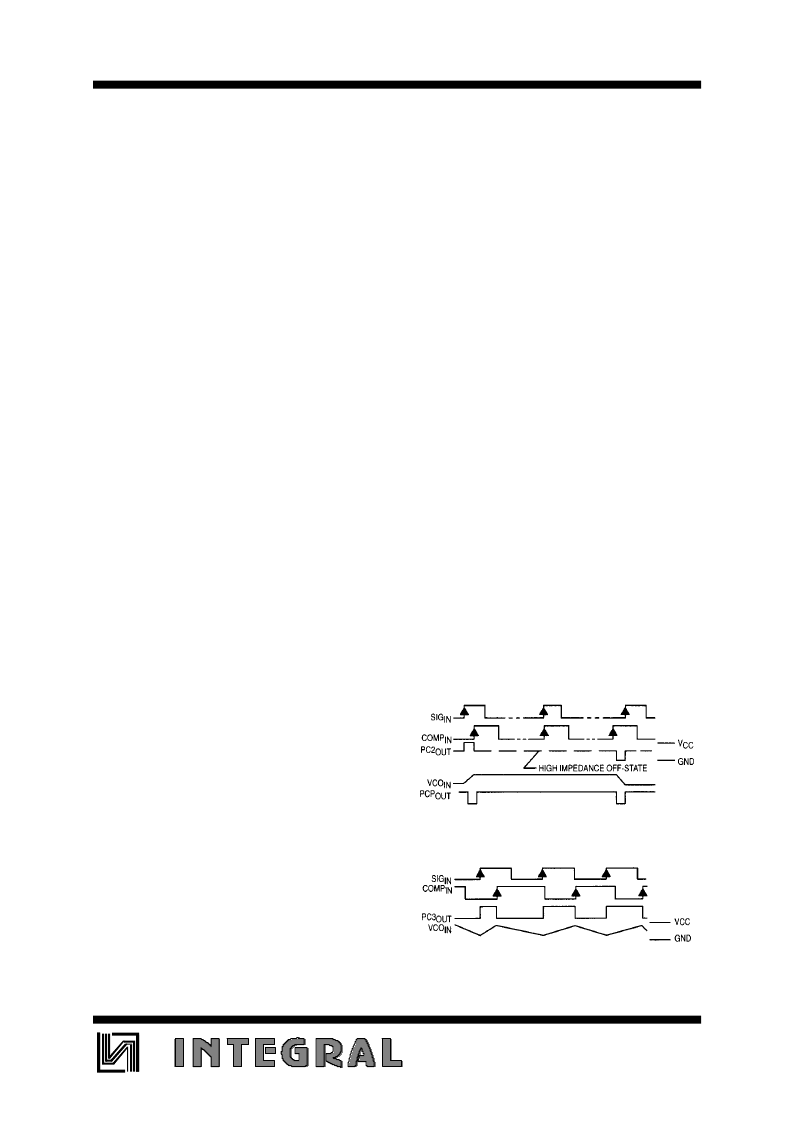- 您現(xiàn)在的位置:買賣IC網(wǎng) > PDF目錄385354 > HC4046 (System Logic Semiconductor Co., Ltd.) Phase-Locked Loop PDF資料下載
參數(shù)資料
| 型號(hào): | HC4046 |
| 廠商: | System Logic Semiconductor Co., Ltd. |
| 英文描述: | Phase-Locked Loop |
| 中文描述: | 鎖相環(huán) |
| 文件頁(yè)數(shù): | 10/12頁(yè) |
| 文件大小: | 134K |
| 代理商: | HC4046 |

TECHNICAL DATA
489
Phase Comparator 2
This detector is a digital memory network. It
consists of four flip-flops and some gating logic, a
three state output and a phase pulse output as shown
in Figure 6. This comparator acts only on the positive
edges of the input signals and is independent of duty
cycle.
Phase comparator 2 operates in such a way as
to force the PLL into lock with 0 phase difference
between the VCO output and the signal input positive
waveform edges. Figure 8 shows some typical loop
waveforms. First assume that SIG
IN
is leading the
COMP
IN
. This means that the VCO’s frequency must
be increased to bring its leding edge into proper phase
alignment. Thus the phase detector 2 output is set
high. This will cause the loop filter to charge up the
VCO input, increasing the VCO frequency. Once the
leading edge of the COMP
IN
is detected, the output
goes TRI-STATE holding the VCO input at the loop
filter voltage. If the VCO still lags the SIG
IN
then the
phase detector will again charge up the VCO input for
the time between the leading edges of both waveforms.
If the VCO leads the SIG
IN
then when the
leading edge of the VCO is seen; the output of the
phase comparator goes low. This discharges the loop
filter until the leading edge of the SIG
IN
is detected at
which time the output disables itself again. This has
the effect of slowing down the VCO to again make the
rising edges of both waveforms coincidental.
When the PLL is out of lock, the VCO will be
running either slower or faster than the SIG
IN
. If it is
running slower the phase detector will see more SIG
IN
rising edges and so the output of the phase
comparator will be high a majority of the time, raising
the VCO’s frequency. Conversely, if the VCO is
running faster than the SIG
IN
, the output of the
detector will be low most of the time and the VCO’s
output frequency will be decreased.
As one can see, when the PLL is locked, the
output of phase comparator 2 will be disabled except
for minor corrections at the leading edge of the
waveforms. When PC
2
is TRI-STATED, the PCP
output is high. This output can be used to determine
when the PLL is in the locked condition.
This
detector
has
characteristics. Over the entire VCO frequency range
there is no phase difference between the COMP
IN
and
the SIG
IN
. The lock range of the PLL is the same as the
capture range. Minimal power was consumed in the
loop filter since in lock the detector output is a high
impedance. When no SIG
IN
is present, the detector will
several
interesting
see only VCO leading edges, so the comparator output
will stay low, forcing the VCO to f
min
.
Phase comparator 2 is more susceptible to noise,
causing the PLL to unlock. If a noise pulse is seen on
the SIG
IN
, the comparator treats it as another positive
edge of the SIG
IN
and will cause the output to go high
until the VCO leding edge is see, potentially for an
entire SIG
IN
period. This would cause the VCO to
speed up during that time. When using PC
1
, the output
of that phase detector would be disturbed for only the
short duration of the noise spike and would cause less
upset.
Phase Comparator 3
This is positive edge-triggered sequential
phase detector using an RS flip-flop as shown in
Figure 6. When the PLL is using this comparator, the
loop is controlled by positive signal transitions and
the duty factors of SIG
IN
and COMP
IN
are not
important. It has some similar characteristics to the
edge sensitive comparator. To see how this detector
works, assume input pulses are applied to the SIGN
IN
and COMP
IN
’s as shown in Figure 9. When the SIGN
IN
leads the COMP
IN
, the flop is set. This will charge the
loop filter and cause the VCO to speed up, bringing the
comparator into phase with the SIG
IN
. The phase angle
between SIG
IN
and COMP
IN
varies from 0
°
to 360
°
and
is 180
°
at f
o
. The voltage swing for PC
3
is greater than
for PC
2
but consequently has more ripple in the signal
to the VCO .When no SIG
IN
is present the VCO will be
forced to f
max
as opposed to fmin when PC
2
is used.
The operating characteristics of all three phase
comparators tors should be compared to the
requirement of the system design and the appropriate
one should be used.
Figure 8. Typical Waveforms for PLL Using
Phase Comparator 2
Figure 9. Typical Waveforms for PLL Using
Phase Comparator 3
相關(guān)PDF資料 |
PDF描述 |
|---|---|
| HC4053 | IC-VLTG REG 125V-1A |
| HC4094 | T-NPN-SI HIGH VLTG AMP |
| HC49J | SM Crystal Formed Leads |
| HC534 | Voltage Regulator IC; Package/Case:3-TO-3; Current Rating:1.5A; Output Voltage Max:-12V; Voltage Regulator Type:Fixed Voltage; Mounting Type:Through Hole |
| HC5503CBZ | Low Cost 24V SLIC For PABX / Key Systems |
相關(guān)代理商/技術(shù)參數(shù) |
參數(shù)描述 |
|---|---|
| HC4046A | 制造商:Motorola Inc 功能描述: |
| HC-405 | 制造商:Thomas & Betts 功能描述: |
| HC4051A-L85H WAF | 制造商:ON Semiconductor 功能描述: |
| HC4052 | 制造商:SLS 制造商全稱:System Logic Semiconductor 功能描述:Analog Multiplexer/Demultiplexer(High-Performance Silicon-Gate CMOS) |
| HC4052A-L85H WAF | 制造商:ON Semiconductor 功能描述: |
發(fā)布緊急采購(gòu),3分鐘左右您將得到回復(fù)。